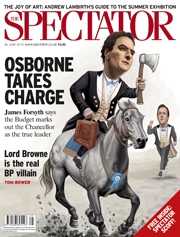 To understand the budget properly, read James Forsyth’s cover story in The Spectator today. Sure, it was about reducing the deficit – but within it lie
several political strategies which explain how George Osborne hopes to win a majority Conservative government. James says that those around Cameron will not entertain this notion – they “have
been persuading themselves that coalition government is the best possible result”. But Osborne, he says, finds it deeply unsatisfactory and has a twin mission: fix the economy, and win
outright next time.
To understand the budget properly, read James Forsyth’s cover story in The Spectator today. Sure, it was about reducing the deficit – but within it lie
several political strategies which explain how George Osborne hopes to win a majority Conservative government. James says that those around Cameron will not entertain this notion – they “have
been persuading themselves that coalition government is the best possible result”. But Osborne, he says, finds it deeply unsatisfactory and has a twin mission: fix the economy, and win
outright next time.
How? The move on tax credits, James says, is a classic example.“He has been observing recently that Gordon Brown spent 13 years successfully creating Labour voters — mainly through state dependency — and that the Tories need to reverse this process if they are to win. It would also mean fostering a new set of Tory voters in the way that Margaret Thatcher did with council house sales and the ‘Tell Sid’ expansion of share ownership. This is the strategy that underpins Osborne’s first Budget.”
And Osborne’s decision not to cut capital spending budgets also has a political implication.“During the election campaign, nearly every Tory candidate despaired at how so many families on £50,000 a year were voting Labour to protect their £545 child tax credit — despite the overall cost of a Labour government to them being far higher than that. Osborne’s Budget dealt with this directly. Within two years, no family earning £30,000 a year or more and with one child will receive tax credits. That class of wavering Labour voters, so irritatingly prevalent in marginal seats, will be no more.”
The sculpting of a new Tory nation, James says, does not end there. Even in those Tory-resistant zones, Scotland and the north, Osborne has a prescription.“This will have two effects. First, it means that spending on the infrastructure which business needs will continue — making Britain a more attractive place to invest and helping the private sector to grow. Second, the axe will now fall even more heavily on current spending in the public sector. This will lead to a significant shrinkage in the army of public sector workers, a group with whom the Tories failed to make much progress at the last election.”
A while ago, James first revealed that Osborne wanted to work from No11 (as Lawson did) rather than the Treasury (as Lamont, Brown and Darling did) so they could knock down the walls and have one big Cameron-Osborne complex. This is how they had worked in Opposition: a pooled staff, and adjoining offices. “But coalition put paid to that. Each needed to work with their Lib Dem deputies. Mr Osborne is now in the Treasury, slowly developing his own centre of political gravity.”“Both Scotland and the north of England have levels of state spending which exceed that of some Warsaw Pact countries in the Soviet era. Rather than try to build a new silicon valley, Mr Osborne is offering a tax break to anyone who sets up a new business in the most state-dependent regions of the country. The aim is to encourage enclaves of entrepreneurship, breeding Shirley Letwin’s ‘vigorous virtues’ and voters receptive to Tory messages”
It is always surprising, in politics, how the distances between offices has a real effect on the power dynamics. There is no underground passage that connects the Treasury to No10 – it’s about a seven-minute walk outside, through security gates, past tourists etc and when Darling was Chancellor he mused how it was a relatively short journey but one you needed a bloody good reason to make. This distance, and the occupancy of two separate power bases, cannot help but de-Jedward Osborne and Cameron. James’ piece is the best analysis I have read on the difference between the two.







Comments